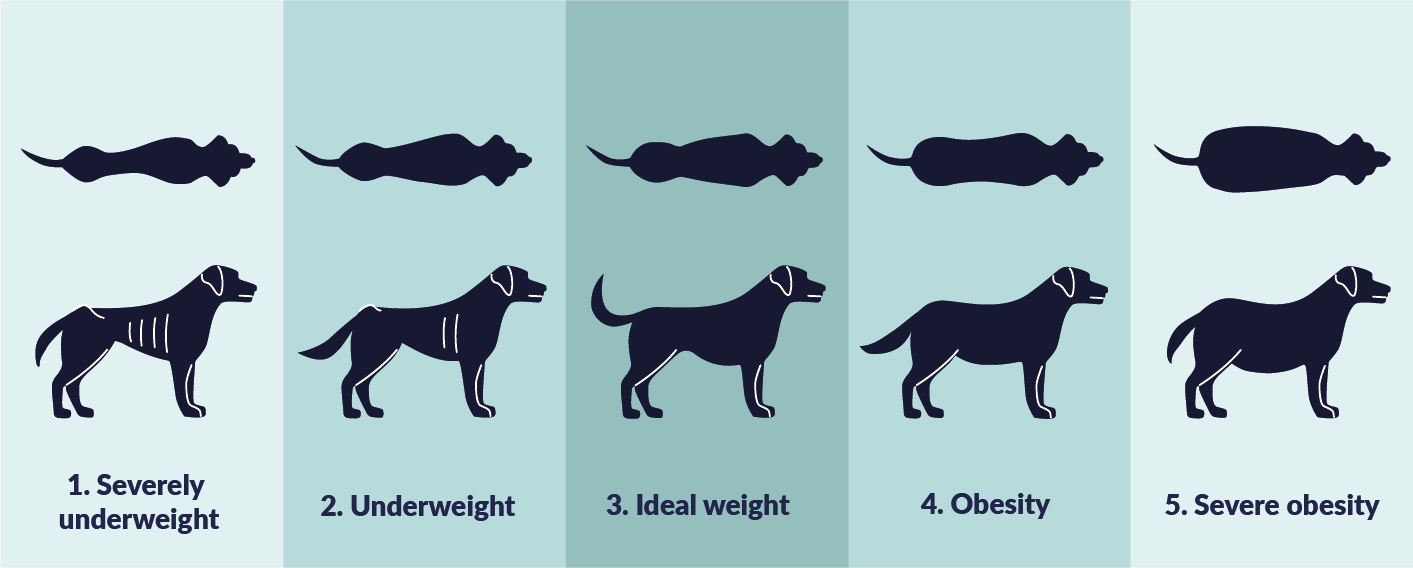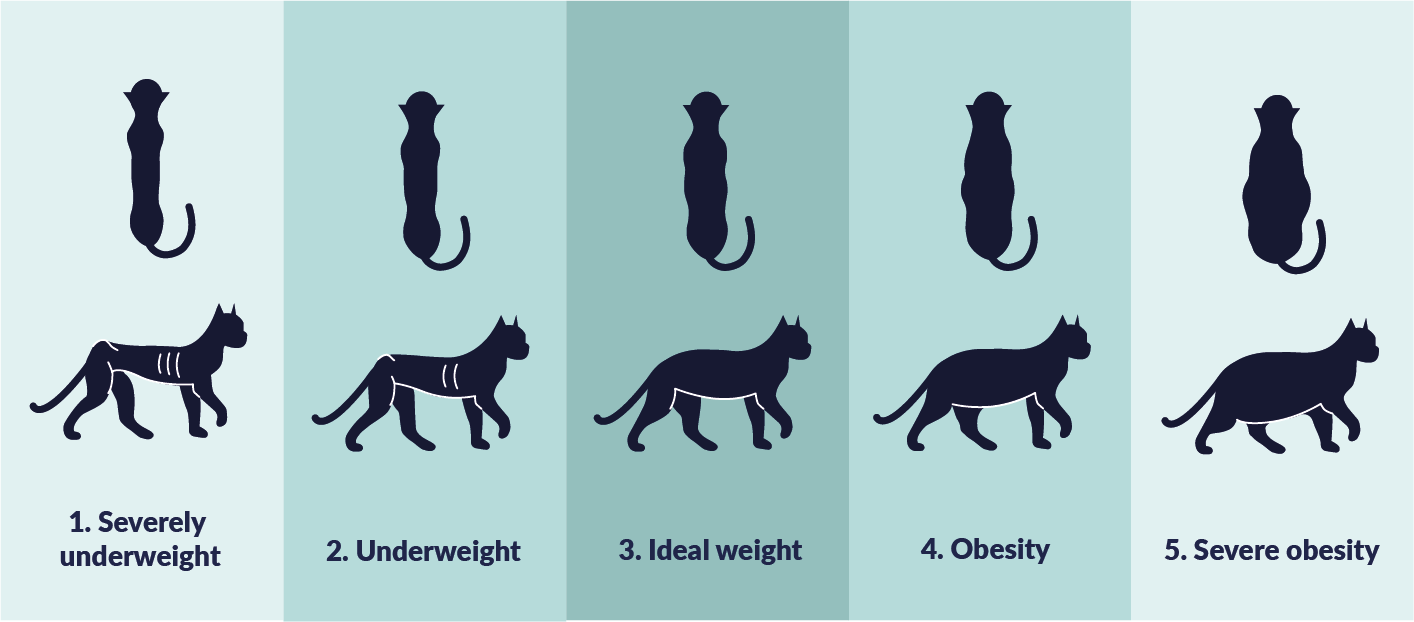Body Condition Scoring (BCS) for Dogs and Cats

Body Condition Scoring (BCS) is a quick and simple way to evaluate your cat or dog’s weight. To help ensure that your pet maintains a healthy weight, you can check their BCS twice a month. Keeping a record of each date and the corresponding BCS overtime is an easy way to be sure that your cat or dog isn’t gaining or losing too much weight. In this article, we’ll describe what you should be looking for, how to evaluate your pet, and what the results mean.
Are you concerned about your pet?
Book a video consultation with an experienced veterinarian within minutes.
- Professional vet advice online
- Low-cost video vet consultations
- Open 24 hours a day, 365 days a year
Weight Guide for Your Dog
Body Condition Score 1-3 = Under Ideal
- 1 - Ribs, lumbar vertebra (lower back), pelvic bones and all bony prominences evident from a distance. No discernible body fat. Obvious loss of muscle mass
- 2 - Ribs, lumbar vertebra, pelvic bones and all bony prominences easily visible. No palpable fat. Some evidence of other bony prominences. Minimal loss of muscle mass
- 3 - Ribs easily palpated and may be visible with no palpable fat. Tops of lumbar vertebrae visible. Pelvic bones becoming prominent. Obvious waist (viewed from above, narrowing in front of the pelvis). Abdominal tuck (viewed from the side, the belly runs upwards from the front legs towards the back legs)
Body Condition Score 4-5 = Ideal
- 4 - Ribs easily palpable, with minimal fat covering. Waist easily noted when viewed from above. Abdominal tuck evident
- 5 - Ribs palpable without excess fat covering. Waist observed behind ribs when viewed from above. Abdomen tucked up when viewed from above
Body Condition Score 6-9 = Over Ideal
- 6 - Ribs palpable with slight excess fat covering. Waist is discernible when viewed from above but is not prominent. Abdominal tuck apparent
- 7 - Ribs palpable with difficulty; heavy fat cover. Noticeable fat deposits over the lumbar area and base of tail. Waist absent or barely visible. Abdominal tuck may be present
- 8 - Ribs not palpable under very heavy fat cover, or palpable only with significant pressure. Heavy fat deposits over the lumbar area and base of tail. Waist absent. No abdominal tuck. Obvious abdominal distention may be present
- 9 - Massive fat deposits over the thorax spine and base of tail. Waist and abdominal tuck absent. Fat deposits on neck and limbs. Obvious abdominal distention

Weight Guide for Your Cat
Body Condition Score 1-4 = Under Ideal
- 1 - Ribs very easily seen on short-haired cats. No fat pads present. Severe abdominal tuck. Lumbar vertebrae and pelvic bones easily seen and felt
- 2 - Ribs easily seen on short-haired cats. Lumbar vertebrae obvious. Pronounced abdominal tuck. No fat pads present
- 3 - Ribs easily felt with minimal fat covering. Lumbar vertebrae obvious. Obvious waist behind ribs when viewed from above. Minimal abdominal fat pads
- 4 - Ribs felt with minimal fat covering. Noticeable waist behind ribs. Slight abdominal tuck. Minimal abdominal fat pads
Body Condition Score 5 = Ideal
- 5 - Well-proportioned. Ribs felt with slight fat covering. Waist seen behind ribs, but not pronounced. Abdominal fat pad minimal
Body Condition Score 6-9 = Over Ideal
- 6 - Ribs felt with slight excess fat covering. Waist and abdominal fat pad present but not obvious. Abdominal tuck absent. (A BCS of 6/9 may be acceptable in some cats, especially older cats.)
- 7 - Ribs not easily felt through moderate fat covering. Waist not easily seen. Slight rounding of the abdomen may be present. Moderate abdominal fat pad
- 8 - Ribs not felt due to excess fat covering. Waist absent when viewed from above. Obvious rounding of abdomen with prominent abdominal fat pad. Fat deposits present over lower back area
- 9 - Ribs not felt under heavy fat cover. Heavy fat deposits over the lumbar area, face and limbs. Distention of abdomen with no waist. Extensive abdominal fat deposits

Get advice from an experienced vet:
- If you notice that your pet is overweight or underweight
- If your pet is losing or gaining weight
- If you need advice on how to manage your pet’s weight, diet, or exercise plan
Read more:
Obesity in Cats: What You Need to Know if Your Favorite Feline is Overweight
How to Choose the Right Food for Your Cat
Obesity in Dogs: What You Need to Know if Your Favorite Canine is Overweight
How to Choose the Right Food for Your Dog
Need to speak with a veterinarian regarding your pet’s weight or another condition?
Click here to schedule a video consult to speak to one of our vets. You can also download the FirstVet app from the Apple App Store and Google Play Stores.
More articles about Dog
Are you concerned about your pet?
Book a video consultation with an experienced veterinarian within minutes.